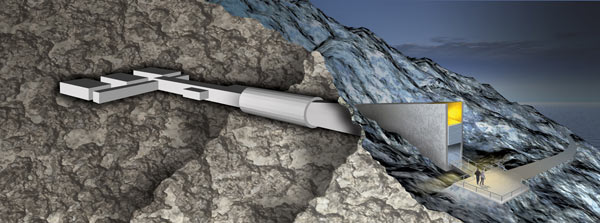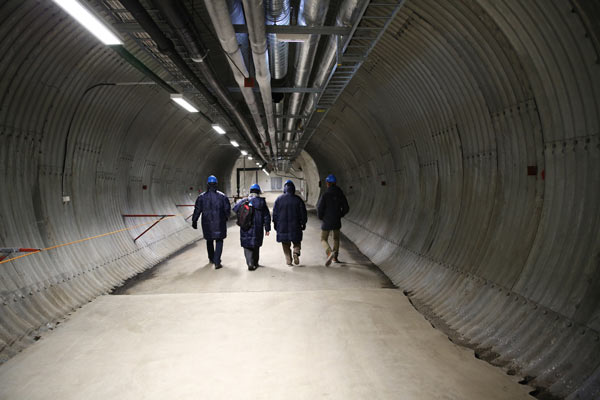The world has a doomsday seed vault in the Arctic, and it just saw a withdrawal

It sounds like something straight out of a sci-fi movie - a giant vault built into a mountain, deep in the frozen wastelands of the Arctic.
But the Svalbard Global Seed Vault is anything but fiction. And if its Norse god-like name didn't already imbue it with a sense of importance, its purpose will - it's meant to protect the world's biodiversity in the face of global crises.
And, in keeping with exactly that goal, the vault, which was started in 2008 just experienced its first withdrawal - by Syria.
Syria's Aleppo seed bank was recently presented with the Gregor Mendel award for continuing to preserve the region's agricultural heritage despite the ongoing and bloody war. The seed bank, which preserved over 1,50,000 seed samples, was damaged in the fighting recently, but luckily, samples had already been sent to the Svalbard vault.
Now, they want to withdraw 130 out of the 325 boxes of seed samples they had deposited - including strains of barley, wheat and grass seeds - to replenish those damaged at the Aleppo seed bank.
With no end in sight to the war, it may not be long before the vault is called into action again.

The vault
According to the United Nations Food and Agriculture Organisation, nearly 75% of the planet's genetic diversity has been lost. It's reckoned that India alone had over 1,00,000 varieties of rice in the past. Today it is home to a few thousand.
The Svalbard vault is our best shot at ensuring the trend not only doesn't continue, but is reversible.
Built out of an old, now-defunct coal mine, the Svalbard vault is the world's largest seed bank. All told, it houses 8,40,000 samples of seeds covering 4,000 species.
Situated on the Norwegian island of Spitsbergen, it's around 810 miles from the North Pole. The site wasn't chosen on a whim. Its remote and inhospitable location means it will almost certainly never encounter an outbreak of war. The region also lacks tectonic activity and the presence of permafrost also aids in the process of seed preservation. Finally, its height (it's 430 feet above sea level) also means that it will not be submerged even if the ice caps melt.
But its creators decided to make it even safer.
The vault employs a variety of methods to keep its bounty of seed samples safe. The first, and most obvious are its giant blast-proof metal doors. What follows is a 120 metre-long tunnel with two airlocks at the end before the actual storage facility begins. Seed samples are stored in special four-ply packets and heat-sealed to remove all traces of moisture. Amazingly, the vault has absolutely no on-site personnel and is monitored by surveillance systems that are controlled in Sweden.
The vault is powered by coal produced in mines in and around the area, allowing it to further cool the seeds to the internationally recommended temperature for storing seeds of -18C. Even in the event of a complete systems failure, the temperature of the vault will take weeks to rise to the level of its surroundings which is still a cool -3C.
At this rate, feasibility studies show that most seed samples stored at the vault could survive for up to 200 years even with a systems failure. Some varieties of grain could survive over a thousand years.

The need for Svalbard
It isn't just war that's destroying global biodiversity.
In an age where genetically-modified crops are increasingly being developed and farmers are ditching ancestral seed strains for newer ones, we're constantly losing out on older strains.
Preserving a rich biodiversity of strains ensures we're able to preserve helpful traits for different seed strains that could defend against future and current pests, diseases and climate change.
Ideally, one would expect the world's large biotech firms - who rely on exactly this sort of information - to focus on crop biodiversity.
The sad truth, though, is that they remain focused on a handful of commercially-viable crops rather than necessarily looking at the big picture.
That being the case, Svalbard's role becomes only more crucial. With natural disasters and wars becoming all-too-common - Philippines' seedbank (now totally destroyed by a fire) was once damaged by flooding, and Iraq and Afghanistan no longer have seedbanks thanks to war - a global safety net to protect the world's biodiversity is imperative.
Fortunately, in a remote corner of the Arctic, there is a vault of hope.







![BJP's Kapil Mishra recreates Shankar Mahadevan’s ‘Breathless’ song to highlight Delhi pollution [WATCH] BJP's Kapil Mishra recreates Shankar Mahadevan’s ‘Breathless’ song to highlight Delhi pollution [WATCH]](https://images.catchnews.com/upload/2022/11/03/kapil-mishra_240884_300x172.png)

![Anupam Kher shares pictures of his toned body on 67th birthday [MUST SEE] Anupam Kher shares pictures of his toned body on 67th birthday [MUST SEE]](https://images.catchnews.com/upload/2022/03/07/Anupam_kher_231145_300x172.jpg)






